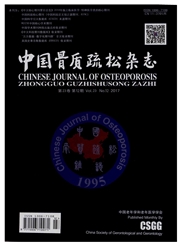

 中文摘要:
中文摘要:
目的探讨JAK2/SATA3信号通路对核因子kB受体活化因子配体(ReceptoractivatorofNF-KBLigand,RANKL)诱导RAW264.7细胞向破骨细胞分化过程的影响。方法用ATP竞争性JAK2激酶抑制剂AG490与RANKL同时处理RAW264.7细胞,倒置显微镜观察细胞形态的变化,抗酒石酸酸性磷酸酶(Tartrate.resistantAcidPhosphatase,TRAP)染色法观察TRAP阳性破骨细胞形态并计数,采用反转录-聚合酶链式反应(reversetranscription-polymerasechainreaction,RT-PCR)检测不同诱导条件下RAW264.7中破骨细胞标志分子TRAP、RANK(ReceptoractivatorofNF-KB)、巨噬细胞标志分子CDllb和Emrl及转录因子活化T细胞核因子(NuclearFactorofActivatedTcellscl,NFATcl)的mRNA表达情况,细胞计数试剂盒(CellCountingKit,CCK8)法检测AG490对RAW264.7细胞增殖的影响,同时应用Westernblot法检测STAT3磷酸化情况。结果ATP竞争性JAK2激酶抑制剂AG490可显著抑制RANKL诱导的RAW264.7细胞向破骨细胞的分化,其作用机制主要是通过下调Ser^727-STAT3磷酸化水平抑制RANKL诱导的RAW264.7细胞增殖、进而导致NFATcl转录因子表达水平下降有关。结论JAK2/STAT3是破骨细胞前体细胞分化成熟过程中的关键信号通路,以此为靶向的特异性抑制剂AG490对于治疗以破骨细胞过度活化为主要特性的疾病具有潜在的应用前景。
 英文摘要:
英文摘要:
Objective To investigate the effect of JAK2/STAT3 signaling pathway on receptor activator of NF-KB ligand (RANKL) induced osteoclastogenesis in RAW264.7 cells. Methods RAW264.7 cells were cultured in the presence of RANKL, and AG490, an ATP competitive inhibitor of JAK2. After 2-day culture, morphologic changes were observed using light microscope. Osteoclasts were determined with tartrate-resistant acid phosphatase (TRAP) positive staining and the muhinuclear cells were counted under light microscopy. The expression of specific osteoclast markers (TRAP and RANK), two macrophagc markers (CDllb and Emrl ), and nuclear factor of activated T cells cl (NFATcl) in mRNA level was analyzed using RT-PCR. The influence of AG490 on cell proliferation was assessed using the cell counting kit (CCK-8). The expression of phosphorylated STAT3 was detected using Western blotting. Results AG490, an ATP competitive inhibitor of JAK2, could significantly inhibit RANKL-induced osteoclastogenesis in RAW264.7 cells. The main mechanism was inhibition of RANKL-induced cell proliferation by down-regulating the level of Scr727-phosphorylated STAT3, thus leading to the down-regulation of NFATcl mRNA expression. Conclusion JAK2/STAT3 signaling pathway plays a key role in the process of maturation and differentiation of preosteoclasts. Inhibitor AG490, specifically targeted in this pathway, has promising application potentials for treating bone diseases characterized by excessive osteoclastogenesis.
 关于刘湘源:
关于刘湘源:
 同期刊论文项目
同期刊论文项目
 同项目期刊论文
同项目期刊论文
 期刊信息
期刊信息
